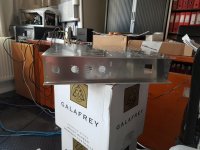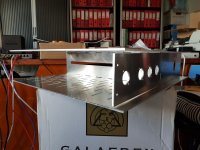Very inspiring. Thank you.
I very much enjoy reading the pages, but I am very much a novice. Hope some one can help.
I have bought the TPA3251 and the PSU from 3eAudio. I have not built it and found this thread extremely exciting.
I have 3 stupid questions:
1. Do I really have to mount the boards on metal standoffs, or will the standard plastic be OK? I was planning for the earth to be next to the IEC AC in. I am a novice.
2. I was not planning a Speaker Protector, is it wise.
3. I am missing the JST connectors from the AC to the PSU and the PSU to the Amp. I understand they are JST connectors 5mm. But the guy from 3e-Audio has run out and is not helping me find them…. can anyone help…
I have attached a photo of my enclosure. I designed it myself.
Thank you.
I very much enjoy reading the pages, but I am very much a novice. Hope some one can help.
I have bought the TPA3251 and the PSU from 3eAudio. I have not built it and found this thread extremely exciting.
I have 3 stupid questions:
1. Do I really have to mount the boards on metal standoffs, or will the standard plastic be OK? I was planning for the earth to be next to the IEC AC in. I am a novice.
2. I was not planning a Speaker Protector, is it wise.
3. I am missing the JST connectors from the AC to the PSU and the PSU to the Amp. I understand they are JST connectors 5mm. But the guy from 3e-Audio has run out and is not helping me find them…. can anyone help…
I have attached a photo of my enclosure. I designed it myself.
Thank you.
Attachments
Looks nice!
No, speaker protection not essential - mine are only in there for a semi placebo effect.
It is probably best practice to ground the board at the designated points of contact but grounding other ways should be fine (not an EE so can't say for certain)
Datasheet says JST5.0-2PIN for power. I think these are JST VHR.
No, speaker protection not essential - mine are only in there for a semi placebo effect.
It is probably best practice to ground the board at the designated points of contact but grounding other ways should be fine (not an EE so can't say for certain)
Datasheet says JST5.0-2PIN for power. I think these are JST VHR.
I hope you mean that next to the IEC connector you will attach both the incoming house earth and a wire from one of the amp board's mounting holes.Do I really have to mount the boards on metal standoffs, or will the standard plastic be OK? I was planning for the earth to be next to the IEC AC in.
That would be OK, but not great. The amplifier designer has exposed AGND at the board's mounting holes for a reason - they intended you to make an earth connection at this point via a standoff. In fact the official TPA3255 evaluation board is delivered with metal standoffs already attached!
I think the DC output is a 2 pin JST "VH" connector, and the AC input is a 3 pin version with the centre pin not connected.I am missing the JST connectors from the AC to the PSU and the PSU to the Amp.
That should help you with Google and eBay.
Guys
Thank you.
I will try and find the JST VH connectors. Even the Element 14 man was confused.
I am a still confused about grounding the AMP board???
“I hope you mean that next to the IEC connector you will attach both the incoming house earth and a wire from one of the amp board's mounting holes.”
Do you mean I have to run a wire from somewhere on the board to the grounding point (near the IEC inlet)? Can I do that from J9 and/or J11 – PSU input connector? The green things??
Thanks
Thank you.
I will try and find the JST VH connectors. Even the Element 14 man was confused.
I am a still confused about grounding the AMP board???
“I hope you mean that next to the IEC connector you will attach both the incoming house earth and a wire from one of the amp board's mounting holes.”
Do you mean I have to run a wire from somewhere on the board to the grounding point (near the IEC inlet)? Can I do that from J9 and/or J11 – PSU input connector? The green things??
Thanks
Be careful here, because the VH-series is 3.81mm/0.15" pin spacing while the 5.0mm version (that looks pretty much identical) is called the NV-series.Datasheet says JST5.0-2PIN for power. I think these are JST VHR.
It's very possible that the three-pin with the middle pin removed is a VH, while the two-pin is an NV - I have seen that before on a commercial PSU. Much swearing ensued when I realised that the connectors weren't the same and I had to reorder the NVs from a different supplier and pay 20 euro postage for 5 euros worth of connectors
Yes, very confusing. I think my ICEpower 50ASX2 used the same connectors. So you could use 50ASX2 cable-set from Ghent Audio -
ghentaudio --- DIY Cable-Set for ICEpower 50ASX2 module
No guarantee, but they look correct.
ghentaudio --- DIY Cable-Set for ICEpower 50ASX2 module
No guarantee, but they look correct.
Linuxfan – Thanks
Thanks. I have emailed Ghent. I think, when I measure between the pins (on the board) it is 3.9mm, but when I search JST 3.9 or even 3.96 I only get 36 results on eBay.
I think it may be 3.96. These cables/connectors are very confusing. While on the 3eAudio it says 5.0, the largest I can find it 3.96…crossing fingers…
Thanks for the tip on Ghent. They seem a good site.
Before I totally lose myself in these strange cables/connectors.
What part of the amp do I connect to the earth? Can I use the J9 or J11 – J11 is free
Thanks. I have emailed Ghent. I think, when I measure between the pins (on the board) it is 3.9mm, but when I search JST 3.9 or even 3.96 I only get 36 results on eBay.
I think it may be 3.96. These cables/connectors are very confusing. While on the 3eAudio it says 5.0, the largest I can find it 3.96…crossing fingers…
Thanks for the tip on Ghent. They seem a good site.
Before I totally lose myself in these strange cables/connectors.
What part of the amp do I connect to the earth? Can I use the J9 or J11 – J11 is free
Attachments
Well if you are not going to use metal standoffs, then yes, J9 or J11 would be OK for a GND attachment point, from which to connect to earth.
Even though you are using J9 for your DC input, you could still share the GND connection here - there's no problem having 2 wires into the same screw terminal.
Even though you are using J9 for your DC input, you could still share the GND connection here - there's no problem having 2 wires into the same screw terminal.
- Home
- Amplifiers
- Class D
- 3E TPA3251 / LRS-350-36 / Hifi2000 Build

